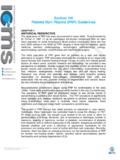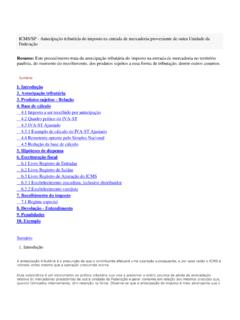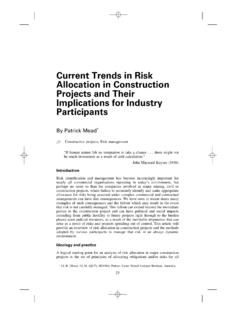Transcription of Guidelines for the Use of Platelet Rich Plasma - ICMS
1 Guidelines for the Use of Platelet rich Plasma Presented by The International Cellular Medical Society DRAFT. Version Committee Members Kim Harmon, MD. Ron Hanson, MD. Jay Bowen, MD. Scott Greenberg, MD. Ed Magaziner, MD. James Vandenbosch David Harshfield, MD. Brian Shiple, MD. David Audley The International Cellular Medical Society ( icms ) asserts that a need exists to create standards for Platelet rich Plasma (PRP) protocols, preparations, techniques and tracking. We believe that physician- led organizations will serve the needs and interests of both patients and physicians toward achieving the best outcomes.
2 In order to advance PRP in particular (and autologous cellular medicine therapies in general), we have developed these Guidelines to assist physicians in performing safe therapies, promote patient education, encourage robust clinical research and begin to define the scope and anticipated effects of these procedures. Platelet rich Plasma : Historical Perspective The application of PRP has been documented in many fields. First promoted by M. Ferrari in 1987 (1) as an autologous transfusion component after an open heart operation to avoid homologous blood product transfusion, there are now over 5200 entries in the NCBI for PRP ranging in fields from orthopedics, sports medicine, dentistry, otolaryngology, neurosurgery, ophthalmology, urology, wound healing, cosmetic, cardiothoracic and maxillofacial surgery.
3 The initial popularity of PRP grew from its promise as a safe and natural alternative to surgery. PRP. advocates promoted the procedure as an organically based therapy that enabled healing through the use of one's own natural growth factors. In recent years, scientific research and technology has provided a new perspective on platelets. Studies suggest that platelets contain an abundance of growth factors and cytokines that can affect inflammation, postoperative blood loss, infection, osteogenesis, wound, muscle tear and soft tissue healing. Research now shows that platelets also release many bioactive proteins responsible for attracting macrophages, mesenchymal stem cells and osteoblasts that not only promote removal of degenerated and necrotic tissue, but also enhance tissue regeneration and healing.
4 Musculoskeletal practitioners began using PRP for tendinopathy in the early 1990s. These early practitioners were primarily trained in the use of prolotherapy. The popularity of PRP grew as physicians began to see clinical results in concentrating a patient's own blood factors. The PRP procedure is significantly more complex and requires additional equipment to perform successfully, but many practitioners have seen a relatively more robust response, fewer treatments and improved tissue health compared to prolotherapy. The growth of PRP therapy has relied primarily on anecdotal or case reports.
5 Historically, there have been few controlled trials to prove the efficacy of PRP. Of these existing trials, the sample sizes tended to be too small to allow for generalization of findings. Moreover, lack of concensus on technique, number of injections, spacing of injections, number of platelets, concentration of platelets over baseline, with or without leukocytes in the injection, exogenous activation of injected platelets and even a definition of appropriate candidates for the procedure are lacking and in need of further definition and evaluation. Recently, however, there has been an emerging literature on the beneficial effects of PRP for chronic non-healing tendon injuries including lateral epicondylosis, plantar fasciopathy and cartilage degeneration (2,3).
6 The current Guidelines will focus on general principles of PRP use and its applications specifically to musculoskeletal care. Future sections will be added in reference to other fields such as dentistry, cosmetics, wound healing, etc. Platelet rich Plasma : Definition and Preparation Considerations By definition, PRP must contain a higher concentration of platelets than baseline, however an increase in platelets is a very gross description of PRP and does not accurately describe the variability among different types of PRP. There are several parameters that need to be taken into account when considering PRP, including: Platelet concentration above baseline, whether or not leucocytes are included, whether or not the PRP has been anticoagulated and whether it requires exogenous activation.
7 Platelet count is the first variable to consider. Absolute Platelet count varies depending on the Platelet concentration in the subjects' peripheral blood. PRP devices can be usually divided into lower ( - 3. times baseline concentration) and higher (5 9 times baseline concentration) systems. It would seem intuitive that a higher Platelet count would yield more growth factors and better clinical results, however, this has not yet been determined. Graziani et al suggested that the optimal concentration of PRP was baseline and above this there may be an inhibitory effect (4).
8 More research is needed. PRP containing white blood cells will have different biologic activity than PRP in which they are absent. The lower Platelet count systems separate the whole blood into two components: one with the cellular components and the other consists of serum in which the platelets are suspended. The higher Platelet count systems separate the whole blood into three fractions: the red cells, serum and buffy coat. The buffy coat contains both platelets and white blood cells (WBCs). WBC can be further classified into different types. These include neutrophils, monocytes/macrophages, and lymphocytes.
9 Their roles in tissue healing are different. Neutrophils are phagocytic and contain over 40 hydrolytic enzymes. Their activation leads to phagocytosis of debris and the release of oxygen free radicals and proteases. This release of toxic molecules from the neutrophils can lead to secondary damage to the muscle (5,6). Whether or not neutrophils have a negative or positive effect on acute or chronically injured soft tissue is unknown. Macrophages are the tissue form of the circulating monocytes. Their role is the removal of debris and they are primarily phagocytic. They also have a role in balancing the pro-inflammatory and anti- inflammatory aspects of healing (5,7) Since it is not possible to fractionate different types of white blood cells out of PRP, it may be that the absence of macrophages is more detrimental to healing than any secondary damage inflicted by neutrophils.
10 More study is also needed in this area. When whole blood is drawn, many PRP kits will use an anti-coagulant to prevent it from clotting. Most kits use anticoagulant citrate dextrose (ACD) to inhibit clotting. ACD binds calcium and prevents the coagulation proteins from initiating the clotting cascade. The addition of citrate to the blood also makes it more acidic than is physiologic. Since some growth factors are influenced by the pH of the tissue, some protocols recommend buffering the PRP back to a physiologic range prior to injection. PRP is activated prior to injection is another parameter that requires further discussion.






